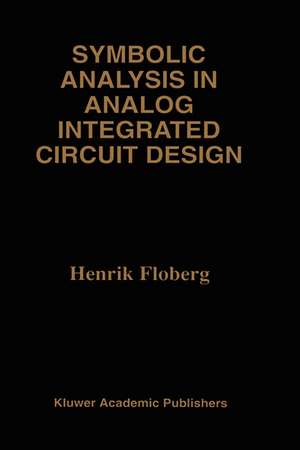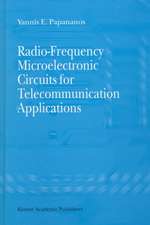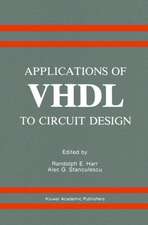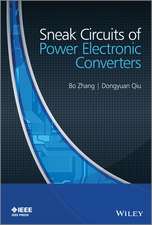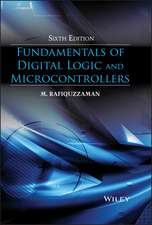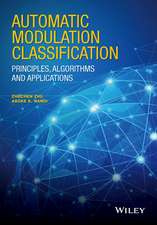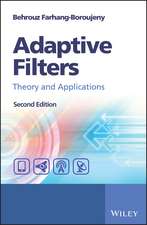Symbolic Analysis in Analog Integrated Circuit Design: The Springer International Series in Engineering and Computer Science, cartea 413
Autor Henrik Flobergen Limba Engleză Hardback – 31 iul 1997
Engineering has been described as `the art of making approximations'. The inclusion of symbolic analysis in analog circuit design reduces the implied risk of ambiguity during the approximation process. A systematic method based on the nullor concept is used to obtain the basic feedback transistor amplifier configurations. Approximate expressions for the locations of poles and zeros for linear networks are obtained using the extended pole-splitting technique. An unusual feature in Symbolic Analysis in Analog Integrated Circuit Design is the consistent use of the transadmittance element with finite (linear or nonlinear) or infinite (i.e. nullor) gain as the only requisite circuit element. The describing function method is used to obtain approximate symbolic expressions for the harmonic distortion generated by a soft or hard transconductance nonlinearity embedded in an arbitrary linear network. The design and implementation of a program (i.e. CASCA) for symbolic analysis of time-continuous networks is described. The algorithms can also be used to solve other linear problems, e.g. the analysis of time-discrete switched-capacitor networks.
Symbolic Analysis in Analog Integrated Circuit Design serves as an excellent resource for students and researchers as well as for industry designers who want to familiarize themselves with circuit analysis. This book may also be used for advanced courses on the subject.
| Toate formatele și edițiile | Preț | Express |
|---|---|---|
| Paperback (1) | 939.33 lei 6-8 săpt. | |
| Springer Us – noi 2012 | 939.33 lei 6-8 săpt. | |
| Hardback (1) | 945.30 lei 6-8 săpt. | |
| Springer Us – 31 iul 1997 | 945.30 lei 6-8 săpt. |
Din seria The Springer International Series in Engineering and Computer Science
- 24%
 Preț: 1041.98 lei
Preț: 1041.98 lei - 20%
 Preț: 643.50 lei
Preț: 643.50 lei - 18%
 Preț: 1225.62 lei
Preț: 1225.62 lei - 18%
 Preț: 965.02 lei
Preț: 965.02 lei - 20%
 Preț: 646.12 lei
Preț: 646.12 lei - 18%
 Preț: 948.79 lei
Preț: 948.79 lei - 20%
 Preț: 646.62 lei
Preț: 646.62 lei - 15%
 Preț: 637.46 lei
Preț: 637.46 lei - 20%
 Preț: 643.83 lei
Preț: 643.83 lei - 18%
 Preț: 949.23 lei
Preț: 949.23 lei - 20%
 Preț: 644.48 lei
Preț: 644.48 lei - 20%
 Preț: 994.92 lei
Preț: 994.92 lei - 20%
 Preț: 645.97 lei
Preț: 645.97 lei - 18%
 Preț: 946.87 lei
Preț: 946.87 lei - 20%
 Preț: 995.57 lei
Preț: 995.57 lei - 18%
 Preț: 956.99 lei
Preț: 956.99 lei - 20%
 Preț: 644.98 lei
Preț: 644.98 lei - 15%
 Preț: 649.54 lei
Preț: 649.54 lei - 18%
 Preț: 950.21 lei
Preț: 950.21 lei - 18%
 Preț: 1221.38 lei
Preț: 1221.38 lei - 18%
 Preț: 957.62 lei
Preț: 957.62 lei - 15%
 Preț: 643.99 lei
Preț: 643.99 lei - 18%
 Preț: 948.47 lei
Preț: 948.47 lei - 18%
 Preț: 947.35 lei
Preț: 947.35 lei - 20%
 Preț: 1284.65 lei
Preț: 1284.65 lei - 20%
 Preț: 1628.31 lei
Preț: 1628.31 lei - 20%
 Preț: 1285.78 lei
Preț: 1285.78 lei
Preț: 945.30 lei
Preț vechi: 1152.81 lei
-18% Nou
Puncte Express: 1418
Preț estimativ în valută:
180.89€ • 193.43$ • 150.82£
180.89€ • 193.43$ • 150.82£
Carte tipărită la comandă
Livrare economică 18 aprilie-02 mai
Preluare comenzi: 021 569.72.76
Specificații
ISBN-13: 9780792399698
ISBN-10: 0792399692
Pagini: 165
Ilustrații: XIII, 165 p.
Dimensiuni: 155 x 235 x 13 mm
Greutate: 0.44 kg
Ediția:1997
Editura: Springer Us
Colecția Springer
Seria The Springer International Series in Engineering and Computer Science
Locul publicării:New York, NY, United States
ISBN-10: 0792399692
Pagini: 165
Ilustrații: XIII, 165 p.
Dimensiuni: 155 x 235 x 13 mm
Greutate: 0.44 kg
Ediția:1997
Editura: Springer Us
Colecția Springer
Seria The Springer International Series in Engineering and Computer Science
Locul publicării:New York, NY, United States
Public țintă
ResearchCuprins
1 Introduction.- 1.1 Symbolic Analysis.- 1.2 Motivation.- 1.3 Book Outline.- 2 Network Theory.- 2.1 Transmission function.- 2.2 Poles and Zeros.- 2.3 Nodes and Ports.- 2.4 Network Elements.- 3 Symbolic Analysis.- 3.1 Circuit Equations.- 3.2 Symbolic Methods.- 3.3 Admittance Matrix.- 3.4 Network Functions.- 3.5 Approximation Methods.- 4 Extended Pole-Splitting.- 4.1 Numerical Roots.- 4.2 Approximate Symbolic Roots.- 4.3 Two-Stage Operational Amplifier.- 4.4 Single-Stage Operational Amplifier.- 5 Compacted Nodal Analysis.- 5.1 Transadmittances.- 5.2 Nullor.- 5.3 Network Functions Using CNA.- 5.4 Block Diagram Elements.- 6 Nullor Synthesis.- 6.1 Two-Port Network.- 6.2 Basic Negative-Feedback Configurations.- 6.3 Nullor Element.- 6.4 Nonideal Transistor.- 6.5 Transistor Implementations of the Nullor.- 6.6 Transistor Amplifiers.- 6.7 Alternative Transistor Amplifiers.- 7 Transistor Models.- 7.1 Network Elements.- 7.2 Nodal Formulation.- 7.3 Nullor.- 7.4 Small-Signal Transistor Models.- 7.5 Approximate Symbolic Expressions.- 8 Symbolic Distortion Analysis.- 8.1 Nonlinear Active Networks.- 8.2 Describing Functions.- 8.3 Examples.- 9 Switched-Capacitor Networks.- 9.1 Switched Capacitor.- 9.2 Equivalent Analog Circuit.- 9.3 Switches and Operational Amplifiers.- 9.4 Switched-Capacitor Amplifier.- 9.5 Switched-Capacitor Biquad.- 10 CASCA.- 10.1 Language.- 10.2 Circuit Description.- 10.3 Graphics.- 11 Conclusions.- A Determinants.- A.1 Definition.- A.2 Minors and Cofactors.- A.3 Cramer’s Rule.- B Cubic Polynomial Equation.- C Describing Function Method.- C.1 Variable Notation.- C.2 Numerical Values.- D CASCA Examples.- D.1 Active RC-Filter.- D.2 Two-Stage Operational Amplifier.- D.3 SC-Biquad.
